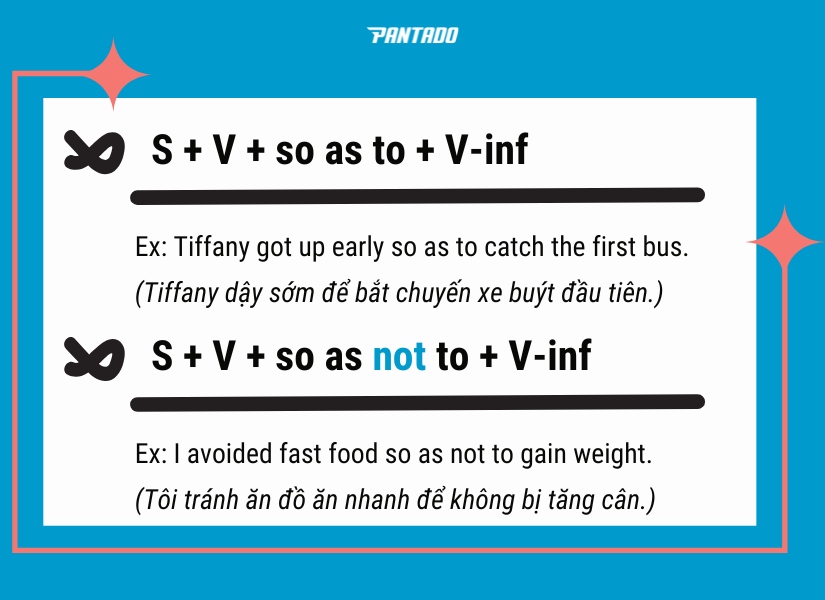Cách Dùng Cấu Trúc In Order To Và So As To | Bài Tập
07/11/2025
Tuyển sinh
“In order to” và “so as to” là hai cấu trúc tiếng Anh được sử dụng phổ biến cả trong học thuật và giao tiếp hàng ngày. Tuy rằng hai cấu trúc đều dùng để chỉ mục đích nhưng lại có sắc thái khác. Tìm hiểu chi tiết hai cấu trúc này trong bài viết dưới đây cùng Pantado.
1. In order to là gì?
“In order to” là một liên từ, có nghĩa là “để, để mà”, được dùng để liên kết mệnh đề chính và mệnh đề phụ, nhằm diễn tả mục đích của hành động.
Cấu trúc “in order to”:
– Khẳng định:
|
S + V + in order to + V-inf |
Ví dụ:
- I study hard in order to pass the upcoming exam. (Tôi học chăm chỉ để vượt qua kỳ thi sắp tới.)
- We need to leave now in order to catch the train. (Chúng ta cần rời đi ngay để kịp chuyến tàu.)
– Phủ định:
|
S + V + in order not to + V-inf |
Ví dụ:
- My husband spoke quietly in order not to wake the baby. (Chồng tôi nói nhỏ để không đánh thức em bé.)
- We turned off the lights in order not to waste electricity. (Chúng tôi đã tắt đèn để không lãng phí điện.)

Cấu trúc "in order to + V"
2. So as to là gì?
Cụm từ “so as to” cũng là một liên từ mang nghĩa là “để, để mà”, dùng để chỉ mục đích khi làm một việc gì đó.
Cấu trúc của “so as to:
– Khẳng định:
|
S + V + so as to + V-inf |
Ví dụ:
- She traveled aboard so as to gain more experience. (Cô ấy đi du lịch nước ngoài để tích lũy nhiều trải nghiệm.)
- Tiffany got up early so as to catch the first bus. (Tiffany dậy sớm để bắt chuyến xe buýt đầu tiên.)
– Phủ định:
|
S + V + so as not to + V-inf |
Ví dụ:
- I avoided fast food so as not to gain weight. (Tôi tránh ăn đồ ăn nhanh để không bị tăng cân.)
- He slowed down so as not to scare the cat. (Anh ấy đi chậm lại để không dọa sợ con mèo.)

Cấu trúc "so as to + V"
5. Bài tập vận dụng
Bài 1: Viết lại câu với cấu trúc “in order (not) to”
1. He trains every day because he wants to join the national team.
2. She locked the door because she didn’t want anyone to come in.
3. I left the party early because I didn’t want to miss the last bus.
4. They study hard because they want to get a scholarship.
5. She avoids fast food because she doesn’t want to gain weight.
6. We took the side road because we wanted to avoid traffic.
7. He spoke softly because he didn’t want to disturb the others.
8. I checked my work twice because I didn’t want to make any mistakes.
Đáp án:
1. He trains every day in order to join the national team.
2. She locked the door in order not to let anyone come in.
3. I left the party early in order not to miss the last bus.
4. They study hard in order to get a scholarship.
5. She avoids fast food in order not to gain weight.
6. We took the side road in order to avoid traffic.
7. He spoke softly in order not to disturb the others.
8. I checked my work twice in order not to make any mistakes.
Bài 2: Khoanh tròn đáp án đúng:
1. She studied all night ___ pass the final exam.
A. with a view to
B. so as to
C. with the aim of
D. in view of
2. He exercises regularly ___ staying fit and healthy.
A. in order to
B. so as to
C. with a view to
D. to
3. They reduced the price ___ attracting more customers.
A. in order to
B. so as to
C. with the aim of
D. in case of
4. The school hired more teachers ___ improve education quality.
A. with a view to
B. in order to
C. so as
D. with the aim
5. She moved to London ___ finding a better job.
A. so as to
B. in order to
C. with a view to
D. because
6. He avoids fast food ___ gain weight.
A. with the aim to
B. in order not to
C. so as not
D. not to
7. They launched a new website ___ increasing online sales.
A. with a view to
B. so as
C. for
D. with
8. I left early ___ not to miss the train.
A. with a view to
B. so as
C. in order
D. in order not to
9. She reads a lot of English books ___ improve her vocabulary.
A. with the aim of
B. in order
C. with a view
D. so that
10. We arranged the meeting ___ discussing the new policy.
A. so as to
B. in order
C. with the aim of
D. so that
Đáp án:
|
1. B |
2. C |
3. C |
4. B |
5. C |
|
6. B |
7. A |
8. D |
9. A |
10. C |
6. Kết luận
Hai cấu trúc “in order to” và “so as to” đều có nghĩa là “để, để mà” và được sử dụng để chỉ mục đích. Tuy nhiên, chúng có sự khác nhau về mức độ trang trọng khi sử dụng trong học thuật và giao tiếp hàng ngày mà chúng ta cần lưu ý. Hy vọng với bài viết chi tiết trên của Anh ngữ Pantado sẽ giúp bạn nắm vững cách dùng của hai cấu trúc này và học thêm được các cấu trúc tương đương khác.
>>> Có thể bạn quan tâm: Lớp học tiếng Anh trực tuyến 1 kèm 1 cho bé tiểu học
_1748229950.jpg)









